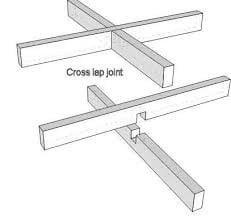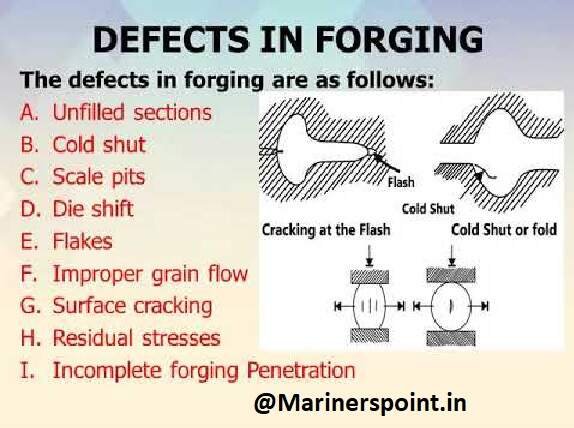Wood joints are very important part of woodworking. In different areas and different situations different types of wood joints are preferred. The type of wood joints will determine the strength of the product.
Carcase work is characterized by box-like shapes of solid wood or laminboard. Typical joints used, are butt or rubbed joint, dowel, tongue and groove, and the screw and slot joint ; other joints include dovetail joints, and corner joints.
Before any joints can be attempted it is necessary to prepare the stuff. This means planing the wood to size and getting four true surfaces.
Constructional woodwork can be divided into two main classes : Framework and Carcase work. In framework, typical joints used, are the various halving joints, mortise and tenon joints, and bridle joints.
1. Halving joint

The aim of these wood joints is to secure the corners and intersections of the framing, and at the same time keep all the face flush, that is, in the same plane. The halving joint, also termed a half-lap joint, may be usefully employed in many types of framing where strength and appearance are of secondary consideration. Various forms of halving joint are shown in Fig.
2. Mortise and Tenon Joint

Mortise and tenon wood joints : This family of joint is a large one and is probably the commonest used by the woodworker. It consists of a rectangular peg (tenon) fitting into a rectangular hole (mortise). Various forms of mortise and tenon joints are illustrated in Fig. In making these joints the tenon is made by shaving only, except that in very wide ones the shoulders may be finished with a plane. After preparing the stuff the position of the tenon and mortise squared on the wood with the pencil and then cut to prepare the pieces making joints.
Two tools have been developed solely for making the wood joints : (1) mortise chisel, and (2) mortise gauge. For general framing work the width of a mortise is about one-third the thickness of the material to be mortised, and the length should not exceed six times the width.
3. Bridle Joint

This types of wood joints is really the reverse of the mortise and tenon joint and is often called the open mortise and tenon. Different forms of bridle joints are shown in Fig.
The marking out is the same as for the mortise and tenon joint, except for the placing of the cut lines. It will be noticed that there is no mortise, but two grooves; and what was a tenon now becomes a slot. The joint is often used where the members are of square or near square section and thus unsuitable for making a mortise and tenon joint of good proportions.
4. Butt or Rubbed Joint

Butt or rubbed wood joints : The fastening of boards edge to edge is frequently necessary to give a wider board, for example, drawing board, table top, counter top, etc. The commonest form of edge joint is the butt or rubbed joint (Fig. 10.48) in which two true edges are joined with glue. If properly done, this joint is very strong. For stuff thicker than 25 mm, additional strength is often provided by the use of dowels or screws and slots. The rubbed joint is made by planing the two edges true with a trying plane.
5. Dowel Joint

Dowel wood joints : The dowelled joint is often used as farming joint in the place of the mortise and tenon joint. This may be used to advantage in many cases, such as the joints in circular work, butt jointing two edges or positioning movable fittings. A typical dowel joint is shown in Fig.
6. Tongue and Groove Joint

Tongue and groove wood joints : Commercially machined boards for edge to edge joining, such as drawing boards, floor boards, and match boards, are tongued and grooved. The tongues are used to provide extra support and additional gluing surface. These may be either self-tongues or loose as shown in Fig. Self-tongues are prepared by cutting a tongue on one edge and a suitable groove on the other with the aid of a matching plane. In those tongues, both edges are trued and then plough grooved.
7. Screw and Slot Joint

Screw and slot wood joints : Where two pieces are to be secured secretly and glue may not be advisable, screw and slot joint can be used. One piece carries the screw, while the other piece has slots cut in it (Fig) to take first the head and secondly the body of the screw.
8. Dovetail Joint

Dovetail wood joints : The dovetail joint is probably the strongest of all corner joints. It was primarily a joint intended to take a strain in one direction, but it has several variations and many applications, particularly in making box or carcase-like constructions–from small boxes to large pieces of furniture. Various forms of dovetail joints are shown in Fig.
There are two methods of this : one is to cut the pins first and then mark the sockets from them, and the other is to cut the sockets first. In the first method the marking out may be done neater, but each piece must be dealt with separately, whereas by cutting the socket first, a number of pieces may be dealt with in one operation. This is perhaps the best method, as the sockets are easier to cut straight and there is saving of time.
9. Corner Joint

Corner joint : There are Cross tongued many ways of joining angles or Figure corners together other than by dovetailing. A few of these are shown in Fig.
10. Lap Joint

In these types of wood joints a piece of wood is laid over and joined to another piece of wood. This is a very strong joint because of the large surface area of long-grain to long-grain wood and the glue surface coverage.
A lap joint can be either a full or half lap. A full lap removes no material from either of the members to be joined, resulting in a joint that is the combined thickness of the two members. A half lap joint, also known as a halving joint, removes material from both members so that the resulting joint is the thickness of the thickest member. In half lap joints, the members are typically the same thickness, with half of each removed.
11. Mitre Joint

The mitre joints (often miter in American English) are the types of wood joints formed by cutting each of two parts to be joined across the main surface, usually at a 45° angle, to form a corner, usually at a 90° angle, though any angle greater than 0 degrees can be used. When the angled cut is done on the side, it is called beveling, even though the resulting joint is still a mitre joint.
A disadvantage of a mitre joint in woodworking is its weakness, but it can be strengthened with a spline (a thin wafer of wood inserted into a slot, usually arranged with the long grain of the spline across the short grain of the frame timber). There are two types of splined mitre joints: one with a long spline that runs the length of the mating surfaces and another with a spline that is perpendicular to the joined edges.
Picture frames, pipes, and molding are all common applications.
12. Dado Joint

A dado (in the United States and Canada), housing (in the United Kingdom), or trench (in Europe) is a slot or trench cut into the surface of a machinable material, typically wood. A dado has three sides when viewed in cross-section. A dado differs from a groove in that it is cut across, or perpendicular to, the grain, as opposed to a groove that is cut with, or parallel to, the grain. Dados are frequently used to attach shelves to cabinetry bodies. See rabbet, which is similar to dado (rebate).
13. Box Joint

A box joint is a type of woodworking joint made by cutting a set of complementary, interlocking profiles in two pieces of wood, which are then joined (usually) at right angles and glued. The glued box joint has a high glued surface area, which results in a strong bond, similar to a finger joint. Box joints are used for the corners of boxes or box-like constructions, hence the name. The joint does not have the same interlocking properties as a dovetail joint, but it is much easier to make and can be mass-produced fairly easily.
14. Knapp Joint

The Knapp joint is also referred to as the Pin and Cove, Pin and Scallop, and Half-moon. It is a visually distinct and aesthetically distinct style of antique joinery that was popular for a brief period of time before being phased out due to the invention of the dovetail machine, which is still widely produced and used today.
Knapp joints were a very strong type of drawer joinery that was also very simple to make compared to other types of wood joints at the time.
These were the different types of wood joints that are available and used according to the requirement. Hope you liked this article. Give us your feedback in the comment section below.
Check Out Other Important Topics
Foundry Tools And Equipment – List, Names & Images
Sand Testing Methods – Full Process
Types of Casting Defects – Complete Overview
Moulding Sand – Properties, Types, Process, MCQs
Plant Layout – Types, Objectives, Principles, Advantages
| IC Engine | Important PDFs | Boilers | Synergy Maritime Exam | Naval Arch | MEO Class 4 |
| Interview Questions | Difference Between | Types of Pumps | Auxiliary Machines | Types of Valves | Home |



